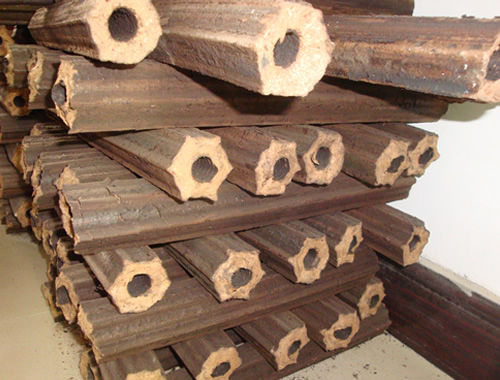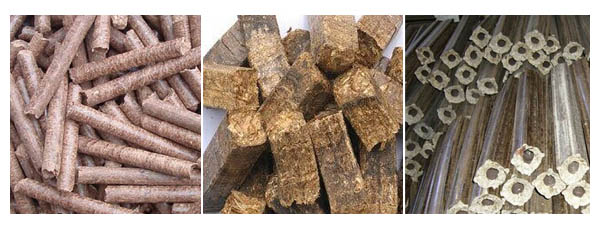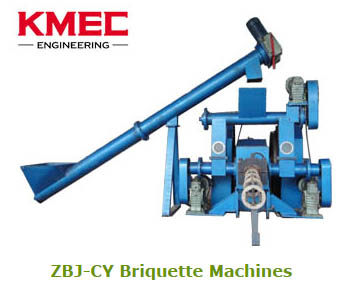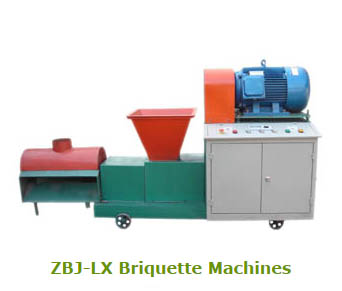FAQ
FAQ about Briquetting Machine
KINGMAN Knowledge
This column is to share knowledge and experience by KINGMAN(KMEC) in biomass equipment and production with clients at home and abroad. KINGMAN(KMEC) dedicates to the solutions for clients to optimize production and maximize interests and profits.
Question1: why during the process of briquetting
are briquettes easily bent?
Answer: as we mentioned in
KINGMAN technique, briquetting depends upon several factors such as material size, drying degree, forming temperature, material type,
compression ratio, tolerance clearance between sleeve and mould (die or screw rod) and so forth. Among the above factors, moisture content of feedstock exerts a great impact on the forming appearance. If the moisture content of feedstock is kept higher than the required, briquettes will be formed in a bent shape. Even some fissure and cracks may occur to briquettes themselves. As it stands, please check up moisture content of feedstock before feedstock is conveyed into
briquette machine, if you demands humidity gauge, KINGMAN also can offer you the small device to detect moisture. Please feel free to contact us.
 Question2: why are briquettes difficult to form?
Question2: why are briquettes difficult to form?
Answer: there may be two causes for it. First, after material size and moisture content of material have been confirmed correctly, temperature of the heater on
briquette machine shall be ensured as well. Before
briquetting, the heater shall be turned on for a period of time for preheating of the forming area in the briquette press, and the following material input can then be started. High temperature can soften feedstock to facilitate the process of compacting and binding them together
Second, the tolerance clearance is also an important factor to decide the forming briquettes. Different materials demand distinguished clearance. Please ensure the accurate clearance can confirmed constantly.
Question3: what is tolerance clearance for briquetting?
Answer: the main components of the mechanical briquetting machines are screw rod (also called spiral spindle) and sleeve. Briquettes are extruded out due largely to the proper tolerance clearance between screw rod and sleeve. Material will be squeezed in the space between the sleeve and screw rod under high temperature and high pressure. The extruding space is called tolerance clearance. And the space is the briquetting zone.
Question4: what is the use of biomass briquettes and pellets
?
Answer:
biomass briquettes and
pellets are made of agro and forestry waste and residuals to help to some extent to alleviate air pollution and carbon dioxide emissions due to their high density and high thermal value of the biomass fuel. It can be used as replacement of renewable resource for conventional fossil fuel such as natural gas, coal. Specifically, biomass briquettes and
pellets can be widely used in domestic fireplaces, small and medium sized biomass boilers and industrial power and heat power plants to enhance combustion rate.
 Question 5: what’s the difference between KINGMAN(KMEC) crusher series and KINGMAN hammer mill series?
Question 5: what’s the difference between KINGMAN(KMEC) crusher series and KINGMAN hammer mill series?
Answer: here are the working principles of the two types of
pulverizers.
KINGMAN(KMEC)
Wood Hammer Mill Working Principle:
High speed rotation of hammers is suitable in dealing with raw materials that have higher brittleness, and the particle size can be more evenly uniform. It is used for middle degree and deep degree crushing and has the features of compact structure, larger capacity, better crushing effect, low power consumption, etc.
KINGMAN(KMEC)
Crusher Working Principle:
It is a combination of chipping and smashing, with the cutterhead chipping raw material into small wood pieces and hammer plates crushing the wood pieces into powdery shape. There’re single
roller crusher and
double roller crusher, featuring low power consumption, low powder rate. But comparing with
hammer mill, its quick-wear parts have shorter lifespan.

 Question6: What are the definition and features of charcoal made with a briquette machine?
Question6: What are the definition and features of charcoal made with a briquette machine?
Answer: Definition and Features of the Machine-made Charcoal
Definition: to make charcoal, a briquette machine is bound to be used processing sawdust, saw shavings, peanut shell, rice husk, corn stalks, cotton stalks and other biomass waste into briquettes. But the raw material shall be pretreated via crushing, drying and sifting prior to put into briquette machine. Regarding briquette machine per se, high temperature and high pressure is the imperative prerequisites, therefore pre-heating coil is mounted. Briquette machine can be matched with molds of different shapes such as column, diamond or square. Since then, briquettes can be charred in a carbonizing furnace in dry distillation.
Features: comparing with conventional charcoal, the ones from briquette machine is characterized by marked mechanical strength, high carbon content and thermal value and prolonged combusting time yet lower ash content, a 2-4 times increase in burning performance. Besides, another outstanding advantage goes smoke-free without pungent smell.
|
Moisture Content |
Carbon Content |
Ash Content |
Thermal Value |
Burning Time |
Volatile Matter |
Burning Temp |
|
0.98% |
83.28 |
3.68% |
7.9Kcal/kg |
200 min |
6.68% |
880 degrees centigrade |
Question7: What is carbonization of briquettes?
Answer:How to convert briquettes into charcoal
Carbonizing furnace remains an important facility turning briquettes into charcoal in dry distillation. The working principle of carbonization goes pretty simple. Specifically, the center-hollow briquettes or even tree branches and twigs, bamboo, timber or lumber can be burnt (or just combusted spontaneously on the surface) and then decomposed into combustible gas, tar and black substance, namely, wood charcoal yet under the anoxic circumstance.
Link to the carbonizing furnace
Briquettes or other materials within the furnace will go through a changing process as follows:
Kindling---heating and drying---high-temperature decomposing---combustion of combustible gas on the material surface---aggravation of decomposition---black matters+combustible gas+tar. The entire process includes temperature rising, heat preserving and temperature falling.
If you're interested in our products or have any questions, please let us know. Don't hesitate to contact us!



